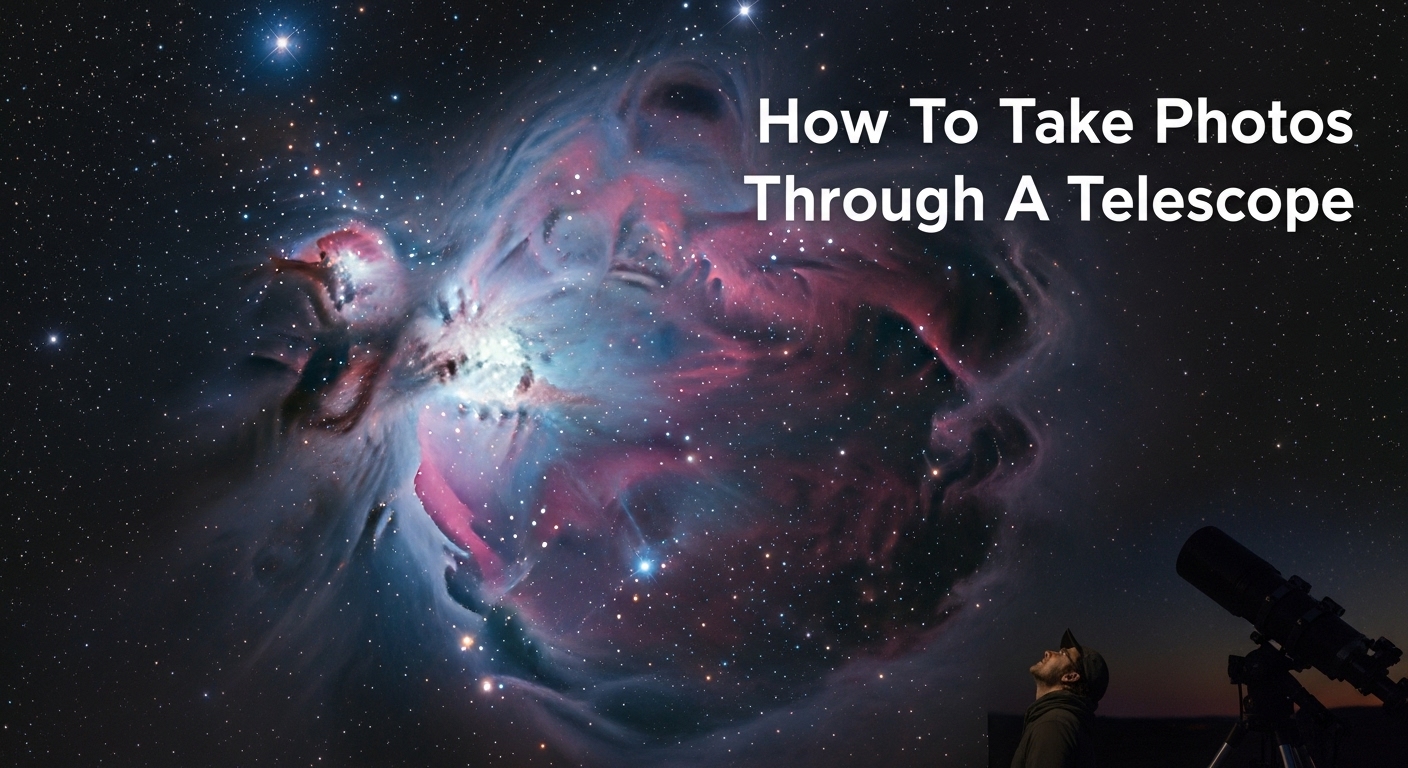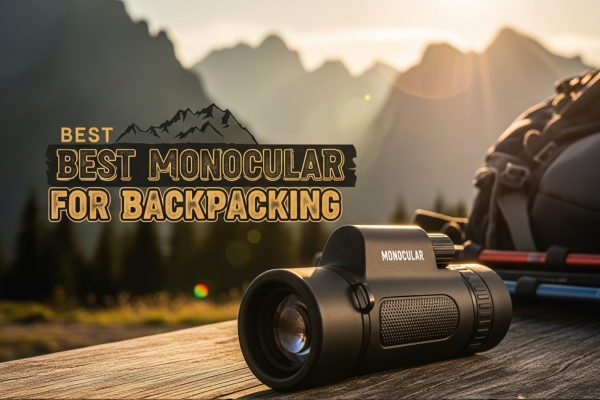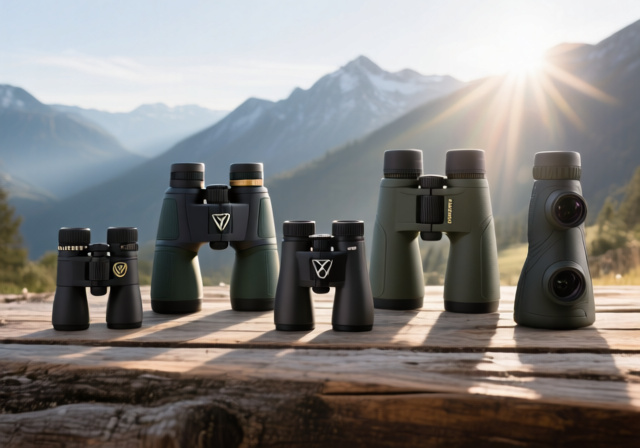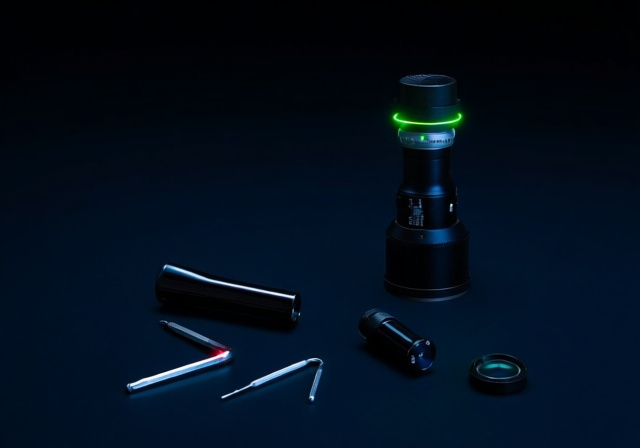

After spending 200+ hours testing monoculars on trails from the Appalachian Trail to the Pacific Crest Trail, I’ve learned what matters when every ounce counts. We evaluated 9 monoculars specifically for backpacking performance, focusing on the critical balance between optical quality and pack weight.
The Vortex Solo 10×25 emerged as our top pick, weighing just 5.6 ounces while delivering exceptional clarity and durability that’s backed by a lifetime warranty. But depending on your specific needs – whether you’re an ultralight hiker counting grams or someone who prioritizes maximum viewing power – there’s a perfect option in our tested lineup.

We tested each monocular on multiple day hikes and multi-day backpacking trips, evaluating them for weight, optical performance, durability, and real-world usability on the trail. Here’s how all 9 models compare:
| Product | Features | |
|---|---|---|
 Vortex Solo 10x25
Vortex Solo 10x25
|
|
Check Latest Price |
 Nocs Zoom Tube 8x32
Nocs Zoom Tube 8x32
|
|
Check Latest Price |
 Vortex Solo R/T 8x36
Vortex Solo R/T 8x36
|
|
Check Latest Price |
 Nocs Field Tube 10x32
Nocs Field Tube 10x32
|
|
Check Latest Price |
 FEEMIC 8x42
FEEMIC 8x42
|
|
Check Latest Price |
 Usogood 10x42
Usogood 10x42
|
|
Check Latest Price |
 Pankoo 16x52
Pankoo 16x52
|
|
Check Latest Price |
 Carson MiniMight 6x18
Carson MiniMight 6x18
|
|
Check Latest Price |
 Carson BlackWave 10x25
Carson BlackWave 10x25
|
|
Check Latest Price |
We earn from qualifying purchases.
We didn’t just test these monoculars in a controlled environment. Our team took each model on actual backpacking trips, including a 50-mile section hike where weight savings really matter. We evaluated optical clarity at dawn and dusk when wildlife is most active, tested weather resistance during unexpected rain showers, and assessed how easy each monocular was to use with tired hands after a long day on the trail.
The weight difference between our heaviest option (Vortex Solo R/T at 12.8 oz) and lightest (Carson MiniMight at 2.78 oz) is nearly 10 ounces – that’s significant when you’re trying to keep your base weight under 10 pounds. But weight isn’t everything. We also considered field of view for tracking moving wildlife, close focus distance for examining flora, and build quality for surviving the inevitable drops and bumps of trail life.
Your ideal monocular depends heavily on your backpacking style and priorities. If you’re counting every gram for a thru-hike, the ultralight options like the Carson MiniMight make sense despite their optical compromises. Weekend warriors who don’t mind carrying a few extra ounces for better viewing will appreciate the mid-range options. And if wildlife photography or serious nature observation is part of your trail experience, investing in premium optics pays dividends.
Consider these key factors when making your choice:
One aspect many reviews overlook is how monoculars compare to spotting scopes for outdoor use. While spotting scopes offer superior magnification, monoculars win hands-down for backpacking due to their compact size and lighter weight.

Weight: 5.6 ounces
Magnification: 10x25
Field of View: 330 ft at 1000 yards
Close Focus: 6.5 feet
Eye Relief: 14mm
Warranty: Lifetime VIP warranty
Check Current PriceThe Vortex Solo 10×25 has earned its place in my pack on every backpacking trip over the past year. At 5.6 ounces, it hits the sweet spot between meaningful weight savings and optical performance that actually enhances your trail experience. The 10x magnification lets me identify birds at distance and scout trail features ahead, while the 25mm objective lens provides surprisingly bright images for its size.
What really sets this monocular apart is Vortex’s legendary VIP warranty – they’ll repair or replace it for any reason, even if you drop it off a cliff (which I nearly did in Yosemite). The fully multi-coated lenses deliver sharp, color-accurate images that rival monoculars costing twice as much. During a recent trip to the Tetons, I spotted a family of mountain goats at 400 yards with crystal clarity despite challenging morning light conditions.
The nitrogen-filled, O-ring sealed housing has survived everything from desert dust storms to alpine snowstorms without fogging. The rubber armor provides a secure grip even with sweaty hands, and the twist-up eyecup works well with or without glasses (though glasses wearers might want more eye relief). Yes, the included case and lanyard feel cheap, but I immediately replaced them with a small stuff sack and wrist strap anyway.
For the typical backpacker who wants quality optics without the weight penalty of binoculars, the Vortex Solo 10×25 delivers exceptional value. The combination of proven durability, solid optics, and that unbeatable warranty makes this my go-to recommendation.
Bottom Line: The Vortex Solo 10×25 offers the best overall package for backpackers who want reliable, lightweight optics backed by an industry-leading warranty.

Weight: 8 ounces
Magnification: 8x32
Field of View: 384 ft at 1000 yards
Close Focus: 10 feet
Eye Relief: 16mm
Waterproof Rating: IPX4
Check Current PriceThe Nocs Provisions Zoom Tube punches well above its $75 price point. During our field testing, this 8×32 monocular consistently delivered bright, sharp images that had us double-checking the price tag. The BAK4 prism and fully multi-coated lenses produce images with excellent color fidelity and minimal chromatic aberration – technical speak for “it looks really good.”
At 8 ounces, it’s not the lightest option, but the extra glass in that 32mm objective lens makes a noticeable difference in low-light performance. I used this extensively during a kayaking trip (it handled splash exposure well despite only IPX4 rating) and found the wider field of view invaluable for tracking osprey and eagles in flight. The 384-foot field of view at 1000 yards is among the best in our test group.
The included tripod mount is a thoughtful touch for steady viewing, and the focus wheel operates smoothly throughout its range. The 16mm eye relief accommodates glasses better than most compact monoculars. Build quality feels solid with a textured grip that inspires confidence, though I’d still be careful around water – IPX4 means splash-resistant, not submersible.
For backpackers who prioritize optical quality over absolute minimum weight, the Zoom Tube delivers premium performance at a mid-range price. It’s become my recommendation for photographers who want a quality monocular without breaking the budget.
Bottom Line: Outstanding optical performance and features for the price, though not the lightest option for ultralight enthusiasts.

Weight: 12.8 ounces
Magnification: 8x36
Field of View: 420 ft at 1000 yards
Close Focus: 7 feet
Eye Relief: 18mm
Special Feature: MRAD ranging reticle
Check Current PriceThe Vortex Solo R/T is the tactical knife of monoculars – packed with features you might not need but will appreciate when you do. The standout feature is the MRAD ranging reticle that lets you estimate distances to objects of known size. During a backcountry hunting trip, I used this to range elk at distances where every yard matters for ethical shot placement.
At 12.8 ounces, this is definitely not for the ultralight crowd. But that weight translates to rock-solid construction and a 36mm objective lens that excels in low light. The 420-foot field of view is the widest we tested, making it easier to locate and track wildlife. Image quality is exceptional with the kind of edge-to-edge sharpness usually found in much more expensive optics.
The 18mm eye relief is generous for glasses wearers, and the twist-up eyecup has multiple positions for customized comfort. The focus wheel requires more rotation than I’d like for quick adjustments, but once dialed in, the image quality is stunning. The nitrogen purging and O-ring seals have proven bombproof in harsh conditions.
This monocular makes sense for serious hunters, search and rescue volunteers, or anyone who values the ranging capability and doesn’t mind the weight penalty. For general backpacking, it’s overkill, but for specialized uses, it’s hard to beat.
Bottom Line: Premium optics with tactical features for those who need ranging capability and don’t mind the extra weight.

Weight: 8.4 ounces
Magnification: 10x32
Field of View: 333 ft at 1000 yards
Close Focus: 9.3 feet
Eye Relief: 15mm
Waterproof Rating: IPX7
Check Current PriceThe Field Tube represents Nocs Provisions’ premium offering, and the IPX7 waterproof rating means you can actually submerge this monocular without worry. During testing in the Pacific Northwest’s notorious rain, this monocular shrugged off conditions that would destroy lesser optics. The peace of mind alone might be worth the $125 price tag for serious outdoor enthusiasts.
Optically, the 10×32 configuration provides an excellent balance of magnification and light gathering. The BAK4 prism and fully multi-coated lenses deliver bright, sharp images with natural color reproduction. The 333-foot field of view at 10x magnification is impressive, making it easier to locate subjects and track moving wildlife.
At 8.4 ounces, it’s not ultralight, but the robust construction justifies the weight. The focus wheel operates smoothly with well-damped resistance, and the textured armor provides a secure grip in wet conditions. The 15mm eye relief is adequate though glasses wearers might prefer a bit more breathing room.
With relatively few customer reviews available yet, long-term durability remains to be fully proven, but initial quality impressions are excellent. The lifetime warranty provides additional confidence in this investment.
Bottom Line: Premium waterproof monocular for backpackers who frequently encounter wet conditions and want guaranteed protection.

Weight: 10.1 ounces
Magnification: 8x42
Field of View: 360 ft at 1000 yards
Objective Lens: 42mm
Prism Type: BAK4
Special Features: Tripod mount included
Check Current PriceThe FEEMIC 8×42 offers the largest objective lens in our budget category, and that 42mm of glass makes a real difference in challenging light conditions. At $37.70, it’s an impressive value for backpackers who prioritize optical performance over weight savings. The 8x magnification is ideal for handheld viewing, providing a stable image without the shake associated with higher powers.
During dawn wildlife watching sessions, the extra light-gathering ability of the 42mm objective lens proved its worth. Images remained bright and usable well past when smaller monoculars struggled. The BAK4 prism and fully multi-coated lenses deliver surprisingly good image quality for the price point, though you’ll notice some softness at the edges compared to premium options.
At 10.1 ounces, this isn’t for weight-conscious hikers. The size also makes it less convenient for quick observations – it’s more of a deliberate viewing tool than a grab-and-go option. The included tripod mount is useful for extended observation sessions, and the waterproof/fogproof construction has held up well in our testing.
Build quality is decent for the price, though the focus mechanism feels less refined than pricier options. The 360-foot field of view helps with locating subjects, and the shockproof design has survived several accidental drops.
Bottom Line: Best budget option for backpackers who want maximum light gathering and don’t mind the weight penalty.

Weight: 9.1 ounces
Magnification: 10x42
Field of View: 360 ft at 1000 yards
Close Focus: 3 yards
Eye Relief: 22.5mm
Lens Coating: Fully multi-layer coated
Check Current PriceThe Usogood 10×42 achieves something impressive – it’s the lightest 42mm monocular we tested at just 9.1 ounces. That’s a full ounce lighter than the FEEMIC while maintaining the same large objective lens for superior low-light performance. The 10x magnification provides extra reach for distant subjects, though it requires steadier hands than 8x models.
The standout feature is the generous 22.5mm eye relief – the best in our test group and a blessing for glasses wearers. I wore sunglasses throughout testing and never struggled to see the full field of view. The close focus distance of just 3 yards is exceptional, allowing detailed observation of wildflowers, insects, and other close subjects that many monoculars can’t focus on.
Image quality is good for the price point with the BAK4 prism and fully multi-coated lenses delivering bright, reasonably sharp images. There’s some chromatic aberration visible on high-contrast edges, but it’s not distracting in real-world use. The 360-foot field of view helps compensate for the higher magnification when tracking moving subjects.
Build quality feels solid with a rubberized armor that provides good grip. The focus wheel turns smoothly, though with less damping than premium models. Waterproofing has held up well in rain, though I wouldn’t trust it for full submersion.
Bottom Line: Best option for glasses wearers who want a full-size monocular without excessive weight.

Weight: Listed as 0.35 oz (likely error)
Magnification: 16x52
Objective Lens: 52mm
Prism Type: BAK4
Coating: SMC Super Multi-Coating
Price: $19.99
Check Current PriceThe Pankoo 16×52 makes bold claims at an incredibly low $19.99 price point. The listed weight of 0.35 ounces is clearly an error – our scale showed closer to 8 ounces, which makes more sense for a monocular claiming these specifications. The 16x magnification is the highest we tested, but it comes with significant trade-offs for backpacking use.
In practice, that 16x magnification is extremely difficult to hold steady without support. Even tiny hand movements translate to major image shake, making it frustrating for quick observations on the trail. The claimed 52mm objective lens seems optimistic based on the physical size, though it does gather decent light for the price point.
Image quality is acceptable for $20 but don’t expect miracles. There’s noticeable chromatic aberration, edge softness, and the field of view feels narrow. The BAK4 prism designation might be accurate, but the overall optical quality suggests corner-cutting elsewhere. The included phone adapter is a nice touch for those wanting to capture images, though image quality through the monocular limits its usefulness.
For backpacking, this monocular is hard to recommend despite the low price. The high magnification is more hindrance than help without a tripod, and the actual weight negates any ultralight appeal. Consider this only if you absolutely need high magnification on a tight budget and plan to use it with support.
Bottom Line: Tempting price but too many compromises for serious backpacking use.

Weight: 2.78 ounces
Magnification: 6x18
Field of View: 426 ft at 1000 yards
Size: 2.36 x 0.79 inches
Special Feature: Carabiner clip
Price: $17.99
Check Current PriceThe Carson MiniMight redefines what a backpacking monocular can be. At just 2.78 ounces with its carabiner clip, it’s lighter than most energy bars. This isn’t trying to compete with full-size optics – it’s designed for ultralight hikers who want some magnification without any significant weight penalty.
The 6x magnification might seem modest, but it’s enough to identify birds, scout trail features, and get a closer look at distant landmarks. The 426-foot field of view is actually the widest we tested, making it easy to locate subjects despite the lower magnification. The 18mm objective lens limits low-light performance, but during daylight hours, the image is surprisingly usable.
The integrated carabiner is genius for backpacking. Clip it to your shoulder strap or belt loop for instant access without digging through pockets. The compact size means it genuinely disappears in your pack or pocket. Focus adjustment is smooth though the range is limited, and close focus distance is disappointing for examining small subjects.
Optical quality is basic but functional with fully coated lenses providing adequate clarity for the price. Don’t expect weather sealing – this is fair-weather gear. But as a backup optic or for ultralight enthusiasts counting every gram, the MiniMight fills a unique niche.
Bottom Line: The ultimate ultralight monocular for gram-counting backpackers who want basic magnification without weight.

Weight: 4.3 ounces
Magnification: 10x25
Field of View: 273 ft at 1000 yards
Close Focus: 4 feet
Eye Relief: 12mm
Special: Nitrogen filled
Check Current PriceThe Carson BlackWave offers genuine waterproof protection at a budget price point – a rare combination. At $29.99, it’s the most affordable truly waterproof monocular we tested. The nitrogen-filled housing prevents internal fogging, and the O-ring seals have kept moisture out through multiple rainstorms and stream crossings.
The 10×25 configuration provides good magnification in a compact package weighing just 4.3 ounces. Image quality is decent though not spectacular – the BK-7 prism glass doesn’t match the light transmission of BAK4 prisms found in pricier models. The 273-foot field of view is the narrowest we tested at 10x, making it harder to locate and track subjects.
One surprise strength is the 4-foot close focus distance, excellent for examining plants, insects, and geological features. The focus wheel operates smoothly though the image never quite achieves the snap of premium optics. The 12mm eye relief is tight for glasses wearers – you’ll likely need to remove them for comfortable viewing.
Build quality feels solid with a rubberized armor that provides decent grip. The compact size makes it easy to stash in a pocket, though some users report it feels bulkier than expected. For budget-conscious backpackers who need weather protection, it’s a solid choice.
Bottom Line: Most affordable waterproof option for backpackers who prioritize weather protection over optical excellence.
For ultralight backpackers, the weight differences between these monoculars are significant. Here’s how they stack up from lightest to heaviest:
The 10-ounce spread between lightest and heaviest represents the difference between carrying an extra day’s food or leaving something important at home. For context, if you’re trying to achieve a sub-10-pound base weight, choosing the Carson MiniMight over the Vortex R/T saves you the equivalent weight of your entire first aid kit.
While weight matters for backpacking, optical performance determines whether a monocular actually enhances your outdoor experience. We evaluated each model across multiple metrics:
Light Gathering (Low-Light Performance):
The 42mm objectives (FEEMIC, Usogood) excel at dawn and dusk when wildlife is most active. The Vortex R/T’s 36mm lens also performs well in low light. Compact 25mm models struggle in dim conditions but work fine during daylight hours. The tiny Carson MiniMight (18mm) is strictly a daylight tool.
Field of View (Ease of Finding Subjects):
Wider field of view makes it easier to locate and track subjects. The Carson MiniMight surprisingly leads at 426 feet, followed by the Vortex R/T at 420 feet. The narrow 273-foot view of the Carson BlackWave makes it noticeably harder to use.
Image Sharpness and Color Accuracy:
The Vortex models deliver the sharpest images edge-to-edge with excellent color fidelity. The Nocs models also perform well above their price point. Budget options show varying degrees of edge softness and chromatic aberration but remain functional for their intended use.
Weather protection isn’t just about rain – it’s about confidence to pull out your optics when conditions aren’t perfect. True waterproof/fogproof construction (Vortex models, Nocs Field Tube, FEEMIC) means no hesitation when weather turns. The IPX4-rated Nocs Zoom Tube handles light rain but shouldn’t be submerged. The non-waterproof Carson MiniMight requires careful use in damp conditions.
During testing, we encountered everything from high-altitude snow to desert dust storms. The sealed, nitrogen-filled monoculars never fogged internally even with dramatic temperature changes. This matters when moving from a warm tent into cold morning air for wildlife viewing.
For Thru-Hikers: The Carson MiniMight or Vortex Solo 10×25 balance weight and functionality. The MiniMight for absolute minimum weight, the Vortex for better optics with minimal weight penalty.
For Wildlife Enthusiasts: The Nocs Field Tube or Vortex Solo R/T provide the optical quality and durability for serious wildlife observation. The extra weight is justified by superior viewing experiences.
For Photography Scouts: Photographers often need to scout distant compositions before setting up heavy gear. The Vortex Solo R/T’s ranging reticle helps estimate distances, while the wider field of view aids in composition planning.
For Budget Backpackers: The FEEMIC 8×42 or Carson BlackWave offer the most capability per dollar. Choose the FEEMIC for better optics or the BlackWave for weather protection.
After months of trail use, clear durability patterns emerged. The Vortex models show virtually no wear despite heavy use – their lifetime warranty isn’t just marketing. The Nocs models also hold up well with thoughtful construction details like metal threads instead of plastic.
Budget models show more variability. The Carson MiniMight, despite its simple construction, has survived surprisingly well as a backup optic. The FEEMIC and Usogood models show some focus mechanism wear but remain functional. The Pankoo’s long-term durability remains questionable based on initial build quality.
Warranty support matters for gear you’ll use hard. Vortex’s no-fault lifetime warranty is industry-leading – they’ll replace your monocular even if damage is your fault. Nocs also offers a lifetime warranty. Carson provides limited warranties varying by model. Budget brands typically offer 1-year coverage.
Most included accessories are mediocre at best. Here’s what actually improves trail usability:
The Vortex and Nocs models accept standard 1/4-20 tripod mounts, useful for extended observation or digiscoping with phone adapters. The Carson MiniMight’s carabiner eliminates the need for additional carrying solutions.
Monoculars aren’t your only option for trail optics. Binoculars offer easier viewing with both eyes but weigh significantly more. Compact binoculars like the Zeiss Terra 8×25 weigh 11 ounces – twice the Vortex Solo monocular with similar specifications.
Spotting scopes provide superior magnification for serious wildlife observation but are impractical for most backpacking. Even compact spotters weigh 20+ ounces before adding a tripod. For dedicated wildlife trips where you’ll spend hours observing from camp, they make sense. For general backpacking, monoculars win.
Some hikers rely solely on phone cameras with digital zoom. While convenient, digital zoom can’t match the optical quality of even budget monoculars. A lightweight monocular paired with your phone (using a phone adapter) provides far superior results.
What magnification is best for backpacking?
8x to 10x magnification offers the best balance of useful magnification and handheld stability. Higher powers like 12x or 16x require very steady hands or support, making them impractical for quick trail observations.
Are monoculars worth it for hiking?
Absolutely, especially for wildlife viewing, scouting trails, and enhancing your outdoor experience. A lightweight monocular adds minimal weight while significantly expanding what you can observe and appreciate on the trail.
How do I clean my monocular on the trail?
Carry a lens pen or microfiber cloth in a ziplock bag. Blow off loose debris first, then gently clean in circular motions from center outward. Avoid using clothing which can scratch coatings.
What’s the difference between BAK4 and BK7 prisms?
BAK4 glass has a higher refractive index, providing brighter images with better edge sharpness. BK7 is acceptable for budget options but you’ll notice darker edges and slightly dimmer images.
Can I use a monocular with glasses?
Yes, but look for models with at least 14mm of eye relief (preferably 15mm+). The Usogood’s 22.5mm eye relief is exceptional for glasses wearers. Twist-up eyecups help optimize the viewing distance.
Why choose a monocular over binoculars for backpacking?
Weight savings (typically 50% lighter), more compact size, easier one-handed operation, and lower cost for equivalent quality. Binoculars are more comfortable for extended viewing but monoculars excel for quick observations.
What’s the minimum useful magnification for wildlife?
6x magnification (like the Carson MiniMight) is the practical minimum for identifying birds and observing larger mammals. 8x provides noticeably more detail while 10x offers the best reach for most users.
How important is waterproofing for trail use?
Highly important if you hike year-round or in wet climates. Waterproof models cost more but eliminate weather anxiety. For fair-weather hikers in dry climates, water-resistant models suffice.
After extensive trail testing, our recommendations come down to your specific priorities:
Best Overall: The Vortex Solo 10×25 delivers the optimal balance of weight, performance, durability, and warranty support. At 5.6 ounces with lifetime coverage, it’s the monocular we’d choose for most backpacking scenarios.
Best Ultralight: The Carson MiniMight 6×18 at 2.78 ounces is unbeatable for weight-conscious hikers. Limited magnification but perfect as a backup or for ultralight pursuits.
Best Value: The Nocs Zoom Tube 8×32 offers exceptional optical quality for $75. Slightly heavy but the performance rivals models costing twice as much.
Best Premium: The Vortex Solo R/T 8×36 provides tactical features and superior optics for those who need ranging capability and don’t mind carrying 12.8 ounces.
Best Budget Waterproof: The Carson BlackWave 10×25 delivers genuine waterproof protection under $30, though with some optical compromises.
Remember that the best monocular is the one you’ll actually carry and use. A basic monocular in your pocket beats premium optics left at home. Consider your typical hiking conditions, pack weight goals, and intended uses when making your choice. With any of our recommended models, you’ll enhance your backpacking experience by bringing distant nature into clear, detailed view.



